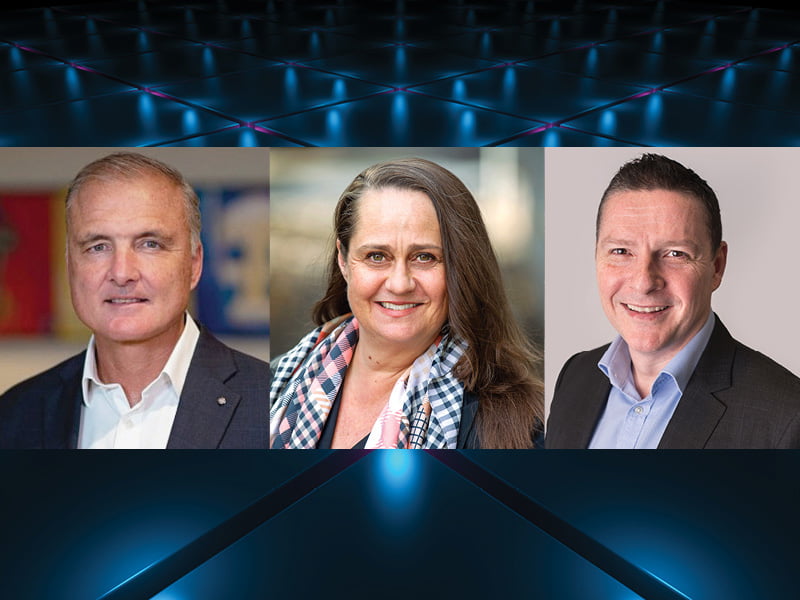What do bushfires and cyber threats have in common? They are both a fact of life; they are both likely to get worse; and we won’t be able to stop either from happening – so we need to be better prepared and to minimise their impact. In short, we need greater resilience.
The issues of resilience against bushfires and cyber threats came together in an Age of Trust podcast with Rear Admiral Lee Goddard CSC, RAN, head of partnership ecosystem, government relations and operations at the Minderoo Foundation and Rob Le Busque, the regional vice-president Asia Pacific at Verizon.
The Minderoo Foundation is a philanthropic organisation that “takes on tough, persistent issues with the potential to drive massive change”. One of those challenges is “to lift Australia to be the global leader in fire and flood resilience by 2025”.

Mr Goddard said national initiatives to build resilience against bushfires were very much in catch-up mode: “We need to do much more, and we need to do it quickly – we need to be using the collective to find innovative solutions.”
He introduced the idea of “pre-resilience”. In the case of bushfire preparedness, this means using the off-season to “make sure every part of our society, from the technology to the behavioural to the human aspects, are resilient and ready for further disruptions to come”.
While there is no off-season for cyber threats, Mr Le Busque said pre-resilience equated to preparedness, but this often fell short of what was required.
“Preparation is everything. It is really your first line of defence from cybercriminals and a large-scale hacking event,” he said.
“A concept we talk about a lot is ‘you never rise to the occasion’. When the pressure’s on, you default to your level of training and preparedness.
“You need to be conscious of the balance between the level of preparation, and the processes and systems you have set up to respond. You need to make sure these represent more than just compliance and are actually actionable programs and systems.”
He added that often, when Verizon is called in to help an organisation respond to a cyber event, they find processes and systems for recovery exist, but they simply don’t work.
“They haven’t been tested,” he said. “Then you see a level of disorganisation that adds to the disruption they are already suffering from.”
The devastating 2019/20 bushfires and, more recently COVID-19, have shown up shortcomings in Australia’s resilience, and the topic is now garnering much attention.
Mr Goddard, who is a rear admiral in the Australian Navy Reserve with a 34 years of full-time Navy service, said there needed to be an increased focus on the resilience of Australia’s infrastructure.
“Our ability collectively to really understand where our critical infrastructure is, its vulnerabilities and how we quickly replace it has been an Achilles heel,” he said. “At the Minderoo Foundation, we are working through, and with, partners to identify this.
“You only know how resilient some of your infrastructure is when the disaster happens. So, you need to really test it: critical communication hubs, critical resource hubs, critical infrastructure that supports dealing with the hazard.”
He said Minderoo’s fire and flood resilience initiative chief executive of Adrian Turner – the former chief executive at CSIRO’s Data61 – was “focusing on data harmonisation and national data coordination to provide knowledge to support better decision-making and information sharing to enable leaders at all levels to really understand where the critical infrastructure is and where the critical weaknesses are in the system”.
However, the resilience of critical infrastructure is now garnering considerable attention. There is legislation before Parliament designed to improve the security and resilience of Australia’s critical infrastructure that greatly increases the scope of what is seen as ‘critical infrastructure’.
In the wake of the bushfires, policy think-tanks Global Access Partners and the Institute for Integrated Economic Research – Australia along with Gravity iLabs set up the GAP Taskforce on National Resilience, a group of 40 representatives from business, government, academia, the not-for-profit sector and the community brought together to “discuss ways to make Australia more resilient to future economic, strategic and environmental threats”.
Australia has a number of resilience-related challenges that go well beyond our border. These increased vulnerabilities mean we need to deliver more effective solutions at greater speed. The disruption of the last 18 months has driven revolutionary change, and we in turn must be revolutionary innovators that ask questions and solve problems no one else has thought of.
The Age of Trust podcast series has been produced as a partnership between Verizon Business Group and InnovationAus.com.
Do you know more? Contact James Riley via Email.
